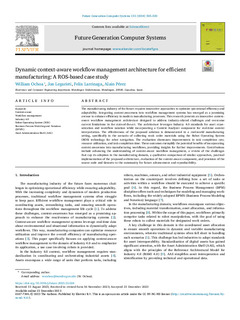Title
Dynamic context-aware workflow management architecture for efficient manufacturing: A ROS-based case studyPublication Date
2024Version
Published versionDocument type
Journal ArticleLanguage
EnglishRights
© 2023 The AuthorsAccess
Open accessPublisher’s version
https://doi.org/10.1016/j.future.2023.12.024Published at
Future Generation Computer Systems Vol. 153. Pp. 505-520Publisher
ElsevierKeywords
Context-aware
workflow management
ODS 9 Industria, innovación e infraestructura
ODS 12 Producción y consumo responsables ... [+]
workflow management
ODS 9 Industria, innovación e infraestructura
ODS 12 Producción y consumo responsables ... [+]
Context-aware
workflow management
ODS 9 Industria, innovación e infraestructura
ODS 12 Producción y consumo responsables
Industry 4.0
Robot Operating System (ROS)
Business Process Modeling and Notation (BPMN)
Asset Administration Shell (AAS) [-]
workflow management
ODS 9 Industria, innovación e infraestructura
ODS 12 Producción y consumo responsables
Industry 4.0
Robot Operating System (ROS)
Business Process Modeling and Notation (BPMN)
Asset Administration Shell (AAS) [-]
Abstract
The manufacturing industry of the future requires innovative approaches to optimize operational efficiency and adaptability. Integrating context-awareness into workflow management systems has emerged ... [+]
The manufacturing industry of the future requires innovative approaches to optimize operational efficiency and adaptability. Integrating context-awareness into workflow management systems has emerged as a promising avenue to enhance efficiency in modern manufacturing processes. This research presents an innovative context-aware workflow management architecture designed to address industry-related challenges and overcome current limitations in the state-of-the-art. The architecture leverages Industry 4.0 standards for asset representation and workflow notation while incorporating a Context Analyzer component for real-time context interpretation. The effectiveness of the proposed solution is demonstrated in a real-world manufacturing setting, specifically in the scenario of collecting work order materials using the Robot Operating System (ROS) technology for robot navigation. The evaluation showcases improvements in task completion rate, resource utilization, and task completion time. These outcomes exemplify the potential benefits of incorporating context-awareness into manufacturing workflows, providing insights for further improvements. Contributions include advancing the understanding of context-aware workflow management, a review of the challenges that cap its adoption in the manufacturing domain, a qualitative comparison of similar approaches, practical implementation of the proposed architecture, evaluation of the context-aware component, and provision of the source code and datasets to the community for future advancement and reproducibility. [-]
xmlui.dri2xhtml.METS-1.0.item-sponsorship
Gobierno Vasco-Eusko Jaurlaritzaxmlui.dri2xhtml.METS-1.0.item-projectID
info:eu-repo/grantAgreement/GV/Elkartek 2022/KK-2022-00007/CAPV/SIIRSE project/SIIRSECollections
- Articles - Engineering [757]
The following license files are associated with this item:






















